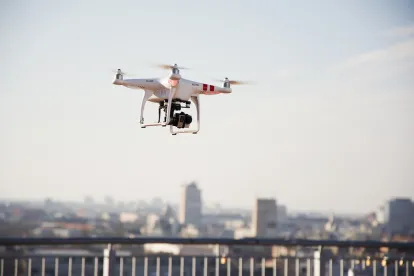Starting on Aug. 29, if you look up, you might spot a drone. The new Small Unmanned Aircraft Systems (UAS or drones) Rule, Part 107, will become effective on Aug. 29. The FAA noted in its release of the new Small UAS Rule that it could generate more than $82 billion for the U.S. economy and create more than 100,000 new jobs over the next 10 years. The new rule offers safety regulations for drones weighing less than 55 pounds (inclusive of payloads).
This rule expressly does not apply to model aircraft operators, who must continue to satisfy the criteria specified in Section 336 of Public Law 112-95. The FAA provided a summary of the Small UAS Rule (Part 107), with various operational limitations, pilot certification requirements, and pilot flight responsibilities.
This new rule may allow commercial operators to avoid applying for a comparatively expensive and time-consuming FAA Section 333 Exemption , or to operate outside of restrictions of an already-issued FAA Section 333 Exemption, by meeting the operational and pilot requirements promulgated in Part 107. Further, commercial operators may even operate outside the bounds of the Part 107 operational limits if they receive a waiver from the FAA that the operation can be performed safely. The FAA is still finalizing its waiver rules, but anticipates considering waiver requests, within 90 days of each request, on the following waivable sections of Part 107:
-
Operation from a moving vehicle or aircraft (§ 107.25)
-
Daylight operation (§ 107.29)
-
Visual line of sight aircraft operation (§ 107.31)
-
Visual observer (§ 107.33)
-
Operation of multiple small unmanned aircraft systems (§ 107.35)
-
Yielding the right of way (§ 107.37(a))
-
Operation over people (§ 107.39)
-
Operation in certain airspace (§ 107.41)
-
Operating limitations for small unmanned aircraft (§ 107.51)
To assist pilots with getting in the air as soon as possible, the FAA has provided a website dedicated to “Becoming a Pilot,” which includes, among other things, the following Part 107 suggested study materials:
-
Airmen Certification Standards
-
Knowledge Test Instructions
-
Knowledge Test Study Guide
-
Knowledge Test Sample Questions
-
Part 107 Advisory Circular
-
Pilot’s Handbook of Aeronautical Knowledge
-
Instructions for first-time remote pilots
-
Instructions for Part 61 pilot certificate holders
The FAA also provides advice regarding the application process for new pilots and existing pilots. For new pilots, the steps generally include:
-
Schedule an appointment with a Knowledge Testing Center (KTC)
-
Pass the initial aeronautical knowledge test
-
Complete FAA Form-8710-13 for a remote pilot certificate using the FAA Integrated Airman Certificate and/or Rating Application system (IACRA)
-
Print a copy of the temporary remote pilot certificate, after the TSA security background check is complete and you have received a confirmation email
-
Receive your permanent remote pilot certificate via mail once all FAA-internal processing is complete
For existing pilots, the steps generally include:
-
Complete the online training course “Part 107 Small UAS ALC-451” available on the FAA FAASTeam website.
-
Complete FAA Form 8710-13 using the FAA Integrated Airman Certificate and/or Rating Application system (IACRA)
-
Validate your identify by presenting a photo identification and a copy of the Form 8710-13 to a FSDO, an FAA-designated pilot examiner (DSE), an airman certification representative (ACR), or an FAA-certificated flight instructor (CFI)
-
A CFI is not authorized to issue a temporary airman certificate, but a FSDO, DSE, or ACR may issue a temporary airman certificate
-
Receive a permanent remote pilot certificate via mail once all other FAA-internal processing is complete





 />i
/>i
